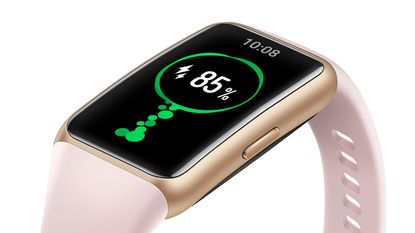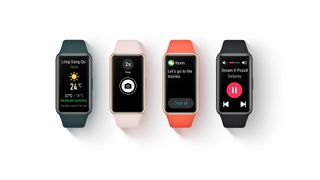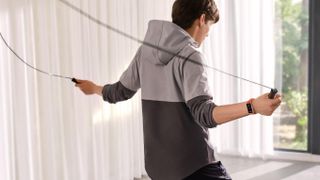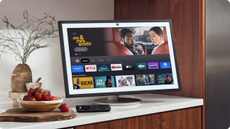Huawei Band 6 review: a competent fitness tracker with a beautiful AMOLED screen and great wellness features
The Huawei Band 6 can track your runs, sleep and even blood oxygen levels fairly accurately. Better still, it's also damn cheap.

The Huawei Band 6 is a capable fitness tracker with a range of health and wellness features for a really good price. If you don’t want to spend big money on a multisport watch but need something that can track everyday activities with relative accuracy, the Band 6 is one of your best options.
-
+
Beautiful AMOLED display
-
+
Decent battery life
-
+
Plenty of health and wellness features on board
-
-
No built-in GPS (it has connected GPS, though)
Why you can trust T3

Huawei Band 6 review TL;DR: a fantastic mid-range fitness tracker with plenty of useful features and a beautiful AMOLED display
I think running watches ruined fitness trackers for me. Testing and reviewing top of the line running watches, such as the Polar Vantage V 2 or the Garmin Enduro, does make fitness trackers look a bit less… capable, so to say. Most fitness trackers have a small screen, limited functionality and their sensors are often not much more than embellishment.
But every now and then I come across a fitness tracker that reminds me that there are indeed decent, inexpensive fitness wearables out there with decent sensors and adequate features. The Huawei Band 6 is one of these fitness trackers and represents a good balance between price, features and attractiveness well.
Huawei Band 6: price and availability
The Huawei Band 6 is available to buy now at Huawei UK and Huawei AUS for a suggested retail price of £59.99/AU$139.
US price and availability TBC.
Huawei Band 6 review: design and build quality
First and foremost we must talk about that '148% bigger' 1.47" FullView AMOLED screen which might sound huge at first but it really isn't that big. That said, it's bigger than those narrow slits of displays cheap fitness trackers have and it's not just bigger but also looks brighter and more featureful than standard fitness band displays. The actual resolution of the display is not too shabby either at 194 x 368 pixels. Oh, and it’s also touch sensitive.
There are plenty of funky watchfaces to choose from that further emphasises the colour and brightness of the band: our favourite was the one featuring the weird looking cat with a duck on its head. Perfect.
The Huawei Band 6 weighs only 18 grams (without the strap) and its case is made of “durable polymer materials”, essentially plastic, but then most fitness wearables nowadays use polymer for their casing so it’s not a comment on the quality of the tracker. The Huawei Band 6 is only water rated to 5 ATM, so you might want to take it off when you shower and you certainly shouldn’t wear it for swimming.

Huawei Band 6 review: features
But the Huawei Band 6 has way more to offer than just a bright screen. It can track heart rate 24/7, just like big league smartwatches, with relative accuracy thanks to its TruSeen 4.0 heart rate monitoring technology that "uses an optical lens and AI-based data processing" to provide more accurate readings.
The HR readings are definitely not all over the place, but as always, wearing the Band 6 correctly is essential in getting those readings right. And even so, since this is wrist wearable, it might not be super accurate anyway. But for tracking heart rate when resting (a.k.a. not working out), it seems more than adequate.
As well as that, the Band 6 is also capable of 'all-day' SpO2 monitoring. The whole idea of blood oxygen monitoring is a bit puzzling as I don't think a lot of people have issues with it (at least we hope so), but having this as an extra feature on board is definitely not a problem.
Other sensor-based features include TruSleep 2.0 Sleep Tracking and quite frankly, sleep tracking on the Huawei Band 6 seems pretty accurate, not to mention the robust sleep analysis section in the Huawei Health app. TruSleep can even give you customised sleep reports, as long as you wear the band for sleeping more than twice a week.
Huawei Band 6 review: battery life
The Huawei Band 6 doesn’t have a GPS chip on board which helps boost its battery life. The ‘up to’ two weeks battery life is not terrible but not amazing either. I’d say, considering the price, I’m certainly not unhappy with how long it lasted in between charges. In comparison, the Fitbit Versa 3 will last ‘up to’ six days but that has a larger screen and also built-in GPS.

Huawei Band 6 review: activity tracking
GPS tracking is delegated to the smartphone which you're supposed to carry around with you if you want the Band 6 to draw a map of your runs after your sessions in the Huawei Health app. Even without the phone, the Band 6 can track distance travelled and with relative accuracy, to my surprise. I wore it for a run with the Polar Vantage M2 and the Band 6's split reminders weren't too far off.
Speaking of running: it’s one of the 96 workout modes the Huawei Band 6 has and it can also estimate VO2 max, suggest recovery time and give you performance stats/training effect estimations, which really isn't too bad from a fitness tracker. During my test runs, the Band 6 didn't show any big swings in either heart rate or pace readings, which is really all we can ask for from a fitness band, especially in this price range.
Huawei Band 6 review: verdict
Probably the best thing about the Huawei Band 6 is that it doesn't try to be a running watch or a smart watch, instead, the Huawei Band 6 does its best to be the best fitness tracker, and as a result it ends up being one. Sure, it's slimmer and more ‘band-like’ than full-blown multisport watches but when compared to other fitness trackers, its best features really set the Band 6 apart from the competition.
I’d say the AMOLED display alone would make the Huawei Band 6 look appealing but thankfully, the features are also great and so are the sensors. In conclusion, the Huawei Band 6 is an amazing fitness band, especially considering the price. For a lot of casual athletes, the Band 6 will provide more than enough functionality with great accuracy. Mid-range fitness trackers don't get much better than this.
Huawei Band 6 review: also consider
The Samsung Galaxy Fit2 offers some good, basic health tracking capabilities wrapped up in a compact and sleek design, at a great price. You wouldn't wear it in order to train for a triathlon, however, and although it’s cheaper than the Huawei Band 6, I would still recommend the latter.
Small, cheap and cheerful, the Garmin Venu Sq is a great Fitbit Versa 3 and Apple Watch alternative fitness tracker for people on a tight budget. Well, it’s three times as expensive as the Huawei Band 6 but at least it grants access to premium Garmin sports features and the wider Garmin ecosystem which is worth every penny.
Sign up to the T3 newsletter for smarter living straight to your inbox
Get all the latest news, reviews, deals and buying guides on gorgeous tech, home and active products from the T3 experts

Matt Kollat is a journalist and content creator who works for T3.com and its magazine counterpart as an Active Editor. His areas of expertise include wearables, drones, fitness equipment, nutrition and outdoor gear. He joined T3 in 2019. His byline appears in several publications, including Techradar and Fit&Well, and more. Matt also collaborated with other content creators (e.g. Garage Gym Reviews) and judged many awards, such as the European Specialist Sports Nutrition Alliance's ESSNawards. When he isn't working out, running or cycling, you'll find him roaming the countryside and trying out new podcasting and content creation equipment.
-
 Forget Black Friday, F1 24 is completely free for a limited time
Forget Black Friday, F1 24 is completely free for a limited timeThis top racing game has a free weekend
By Max Freeman-Mills Published
-
 Devialet Astra is surely the most beautiful audio amp ever made
Devialet Astra is surely the most beautiful audio amp ever madeFrench brand Devialet is renowned for its stunning-looking audio products, but this is on another level
By Rik Henderson Published
-
 Amazon Echo Show range expands... literally – new 21-inch model and Echo Show 15 now available
Amazon Echo Show range expands... literally – new 21-inch model and Echo Show 15 now availableAmazon announces two new Echo Show models, including its biggest yet
By Rik Henderson Published